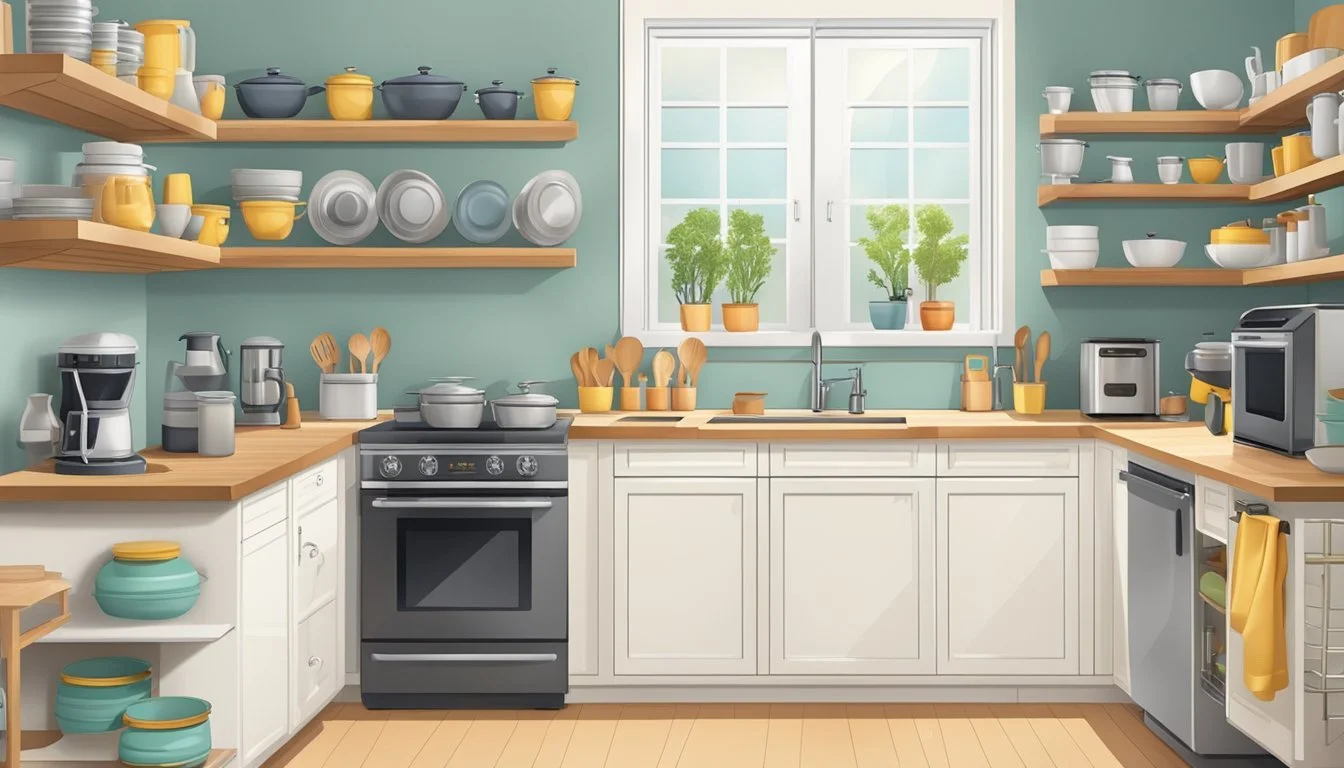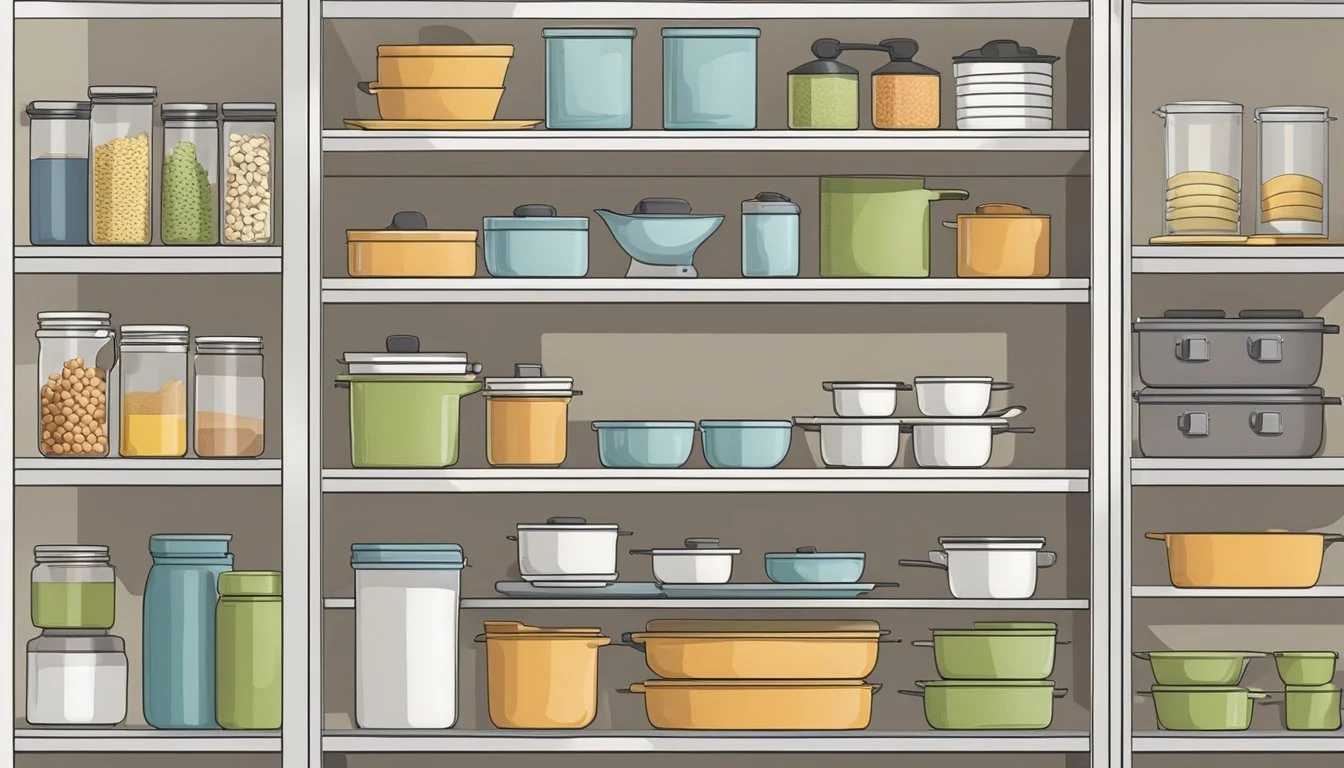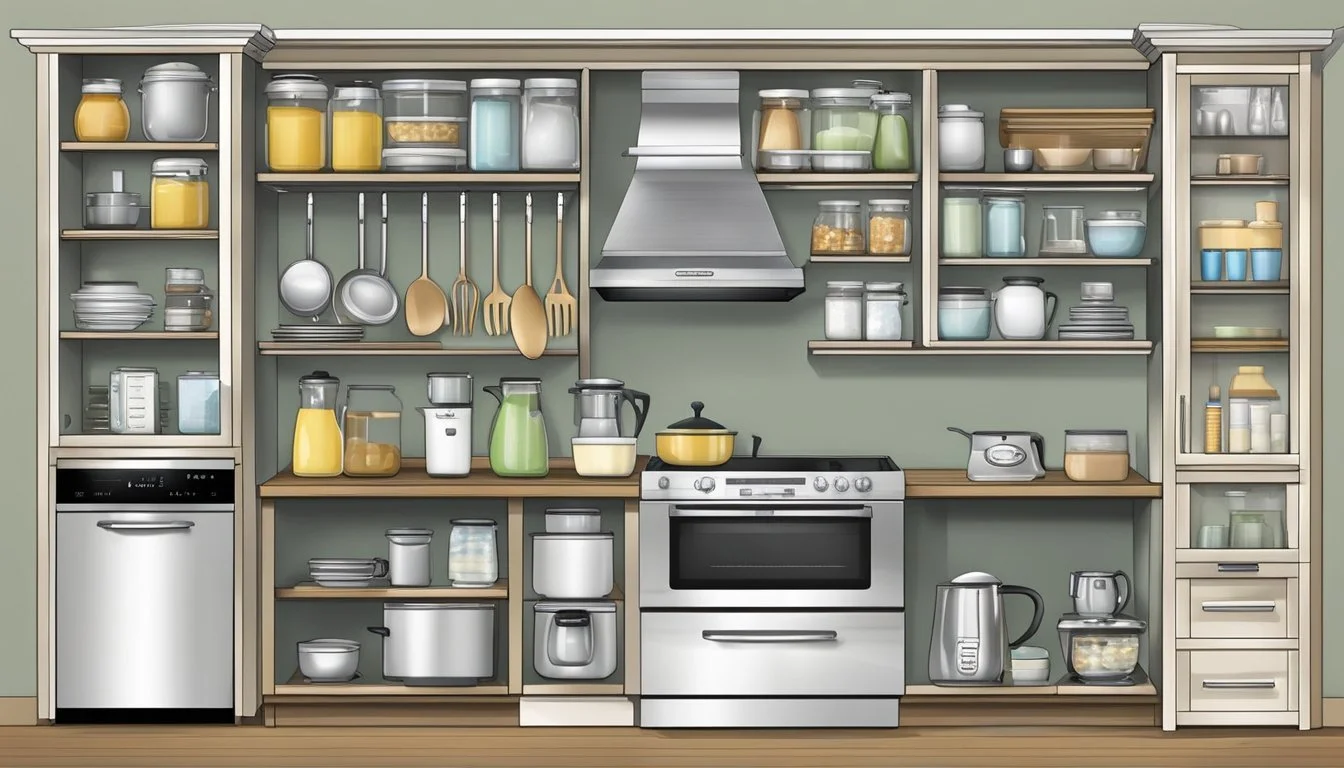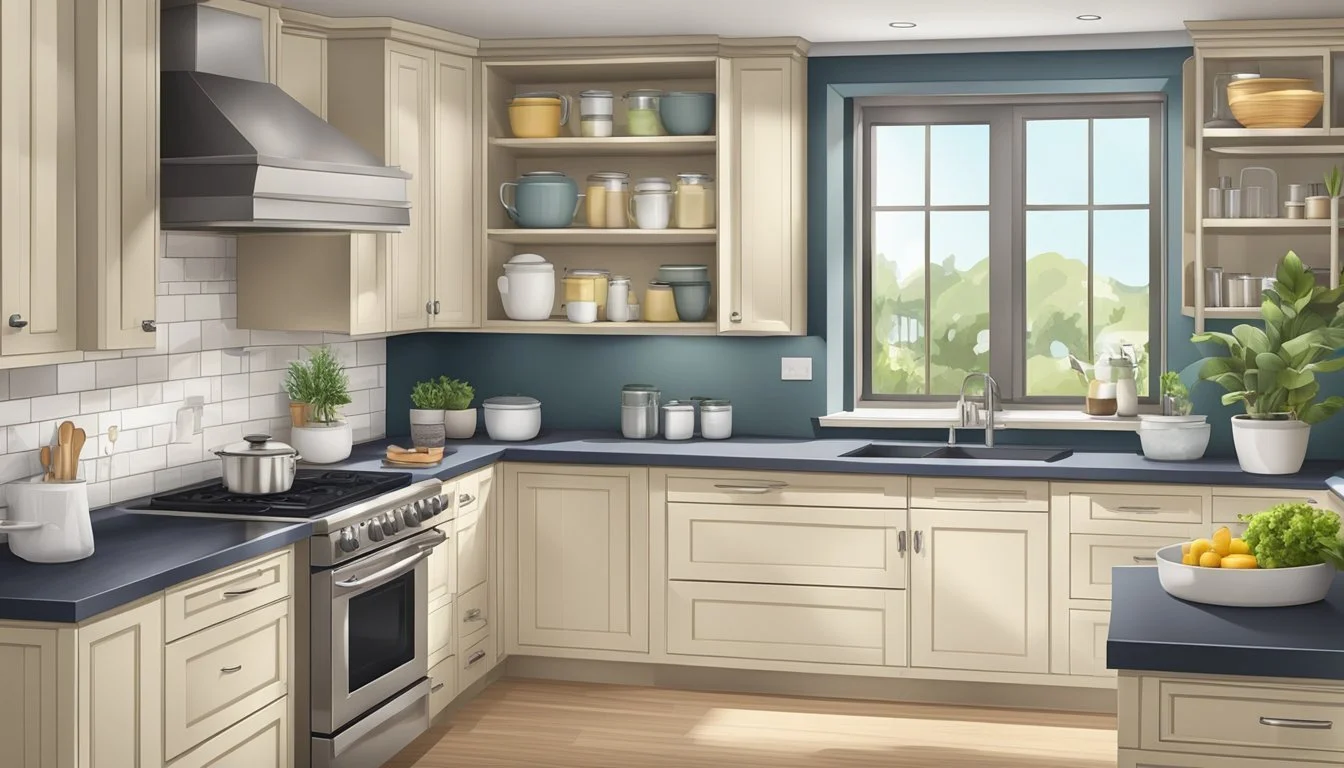The Ultimate Guide to Organizing Your Kitchen Appliances
Streamlining Your Cooking Space
Organizing kitchen appliances can transform a cluttered kitchen into a model of efficiency and ease. The key is to approach the task with a plan that balances function with aesthetics. This involves recognizing the diversity of appliances in a typical kitchen, from frequently used items like kettles and toasters to seldom-used gadgets such as ice cream makers or waffle irons. Allocating space based on usage ensures that the essentials are within easy reach, while occasional items are stored out of the way but still accessible.
To achieve this balance, innovative storage solutions and organizational strategies become indispensable. Options range from built-in appliance garages and custom cabinetry to rolling carts and open shelving. Implementing these solutions effectively requires an understanding of the space available and the best way to maximize it without overcrowding. Moreover, thoughtful organization can extend to the digital realm, where appliance manuals and warranties can be stored online to reduce paper clutter.
Creating separate stations for different activities, using clear labeling for small parts, and grouping appliances by use are some of the practical steps that contribute to an organized and functional kitchen. With the right approach, anyone can transform their kitchen into a well-ordered space that makes cooking and entertaining a pleasure, streamlining tasks, and reducing the time spent on searching for and rearranging seldom-used appliances.
Understanding Your Kitchen Space
Before diving into organization, one must first understand the available kitchen space, which involves assessing needs, evaluating storage options, and prioritizing workflow to optimize functionality and efficiency.
Assessing Your Needs
The first step they should take is to assess the number and type of kitchen appliances they have. Each person should list their appliances, noting how often each one is used—daily, weekly, or rarely. This helps determine which appliances need to be most accessible.
Evaluating Storage Options
When it comes to evaluating storage options, they need to consider the relationship between space and accessibility. They should inspect their countertops, cabinets, and any additional storage space. Available spaces can include:
Drawers: For smaller, frequently used items
Cabinets: Adjustable shelves can accommodate various appliance heights
Countertops: Ideal for appliances used daily, but should remain uncluttered
Prioritizing Workflow
In order to maintain a functional kitchen, they must prioritize workflow. This involves arranging appliances in a manner that contributes to a smooth culinary process. Considerations include:
Proximity: Keeping appliances that work together near each other
Frequency of Use: Storing frequently used items at arm's reach
Space Management: Utilizing corners and vertical spaces wisely
Decluttering and Organizing Principles
The reader will gain insight into effective methods for reducing kitchen appliance clutter and establishing a system that ensures a functional and tidy kitchen environment.
The Pare Down Process
The initial step involves a meticulous evaluation of each kitchen appliance to determine its necessity. Householders should remove any appliance that has never been used or is seldom used from the primary kitchen area. These items create unnecessary cabinet clutter and should be considered for donation or recycling if in good working condition.
Categorization Strategies
One can sort their kitchen appliances into distinct categories based on type or function. For instance, all baking appliances could be grouped together, as could all food prepping appliances. This categorization aids in locating and storing appliances logically and efficiently.
The 'Frequently Used' Rule
Appliances that are used frequently should be given priority in terms of storage location. These should be placed in easily accessible cabinets or on countertops, if appropriate. Conversely, items used less often can be stored in less accessible areas or even outside the kitchen if space is an issue.
Donating and Recycling
When decluttering the kitchen, homeowners should consider the donate or recycle options for appliances that are functional but not needed. Donation can extend an appliance's life and usefulness to others, while recycling allows for responsible disposal of items that can't be repaired. This not only helps declutter the home but also supports environmental sustainability.
Maximizing Cabinet and Drawer Space
In the quest for an organized kitchen, effectively using cabinet and drawer space is paramount. This section will delve into practical techniques to enhance the usability and efficiency of these storage areas, helping homeowners avoid clutter and maintain order.
Shelf and Drawer Utilization
Maximizing shelf space begins with assessing the contents of one's kitchen. Homeowners should prioritize accessibility for frequently used items by placing them at the front of cabinets or middle drawers. Less frequently used items can be stored higher or lower in the cabinets. Utilizing drawer dividers for utensils, cutlery, and small gadgets can drastically improve the ease with which one finds and retrieves these items, thereby keeping drawers orderly.
Cabinet Doors and Vertical Storage
To optimize cabinet space, one can employ the backs of cabinet doors. Attaching adhesive hooks or over-the-door organizers can create additional storage opportunities for items like pot lids or measuring cups, minimizing clutter. Vertical storage strategies may include installing tiered shelves which leverage the height of cabinets, allowing for the organized placement of canned goods and spices.
Use of Organizers and Risers
Organizers and risers are instrumental in doubling cabinet real estate. Inserting a shelf riser in a cabinet gives a home to dishes and cups, enabling one to store more items in the same space. Pull-out drawers and cabinet expanders in lower cabinets can make it easier to reach pots and pans. For deep cabinets, turntables or lazy Susans can make every inch of space easily reachable, eliminating the need for rummaging through contents.
Countertop Management
Effective countertop management strikes a balance between aesthetics and functionality, allowing for both ease of use and a clutter-free space. It is essential to prioritize the placement and organization of appliances and tools for a seamless kitchen experience.
Appliance Garage and Kitchen Tools Area
The concept of an Appliance Garage involves designating a specific zone on the countertop for housing frequently used small appliances. It acts as a dedicated hub, often featuring pull-out drawers or swing-out cabinets, to store items such as toasters, blenders, and mixers. Within this space, it is beneficial to include a section for essential kitchen tools for easy access without overcrowding the countertop.
Creating a Functional Coffee Station
A Coffee Station should serve as both a specialized area and a statement piece of the kitchen. Strategically place the coffee maker, grinder, and bean storage in an easily accessible area. Utilize a rollout shelf or tray to keep coffee accessories and condiments organized, ensuring the station remains tidy and inviting.
Coffee Station Essentials Description Coffee Machine Place on the counter for daily use. Grinder Right beside or under the machine for fresh grounds. Accessories Store filters, scoops, and stirrers in an adjacent drawer or container.
Managing Small Appliance Placement
For small appliances that are not used daily, a minimalist approach is advisable—store them in cabinets or on shelves to reduce clutter. Consider the frequency of use and ensure that the most utilized appliances are easily reachable, ideally at the front of cabinets or on lower shelves. Baskets can be handy for managing appliance cords and smaller parts, keeping the countertop clean and ready for meal prep.
Strategic Pantry and Open Shelving Use
Strategic pantry organization and open shelving not only make kitchen storage efficient but also transform how one utilizes kitchen space for both functionality and aesthetic appeal.
Maximizing Pantry Layout
The layout of a pantry should facilitate easy access and visibility. One starts with emptying the shelves to assess what items are present and categorize them. Creating a zone system within the pantry is crucial—it helps in grouping similar items together, such as baking supplies or canned goods. The use of transparent containers for items like pasta or rice can both improve visibility and keep the contents fresh. Here’s an idea of how to categorize pantry zones:
Baking Zone: All baking ingredients together in one area.
Snack Zone: Easy-to-reach place for kids’ snacks and grab-and-go items.
Canned Goods: Grouped together, possibly on lower or higher shelves based on frequency of use.
In addition to categorizing, deep pantry shelves can be made more efficient by using sliding baskets or tiered shelf organizers to prevent items from being hidden in the back. Labels are another essential feature—they should be bold and clear to identify contents at a glance.
Effective Use of Open Shelving
Open shelving in the kitchen brings a combination of ease and style to storage. The most-used appliances or dishware should be placed on these shelves for quick access. Mixing storage with decorative elements can elevate the look of a kitchen while keeping it practical. Consider the following points for open shelving:
Height and Depth: Arrange items based on how often they are used; everyday items should be within arm's reach.
Consistent Containers: Use similar containers for a cohesive look which can also assist in easily spotting items.
Limit Clutter: While open shelving is great for accessibility, it can easily look cluttered. Only store what you need and use regularly, keeping the rest behind closed cupboard doors.
Open shelving should not be overloaded. Heavier items might be better suited to lower shelves or different storage areas entirely to ensure safety and maintain shelf integrity. Glass jars and containers can be used for showcasing pantry staples and make re-stocking simpler, helping one avoid buying what they already have. Remember to maintain space between items to avoid a crowded appearance and allow for easy retrieval of each item.
Specialized Storage Solutions
Streamlined storage solutions are critical in achieving an organized kitchen. These tactics focus on commonly cluttered items like pots, pans, and bakeware. They also address the tidy arrangement of plates, spices, and linens, ensuring each item has a dedicated and accessible spot.
Pot and Pan Organization
Pots and pans can be organized using hanging pot racks or by utilizing heavy-duty hooks mounted under cabinets. For more concealed storage, homeowners can opt for deep pull-out drawers with adjustable dividers, keeping their cookware stacked neatly and in easy reach.
Storing Baking Pans and Sheets
Baking pans and sheets are best stored vertically in narrow cabinets or compartments. Dividers or tension rods can keep items separated and upright. Toe-kick drawers at the base of cabinets offer a clever space-saving solution for flat baking equipment, such as cookie sheets and cutting boards.
Organizing Plates, Spices, and Linens
Plates are ideally stored in racks within cabinets or on open shelves with plate grooves for stability. Spices benefit from magnetic racks on the fridge or tiered organizers in a cabinet for visibility. Linens can be stored folded neatly in a dedicated drawer or basket, ensuring they are clean and wrinkle-free for use.
Ease of Access and Appliance Frequency
The organization of kitchen appliances should prioritize accessibility and consider how often each appliance is used. This ensures that essentials are within easy reach and helps maintain an efficient and orderly kitchen space.
Organizing for Easy Reach
To maintain an efficient workflow in the kitchen, it’s crucial to place frequently used appliances in accessible locations.
Countertops: Reserve countertop space for daily essentials like coffee makers and toasters.
Lower Cabinets: Stow heavier items like blenders and food processors within lower cabinets, preferably on pull-out shelves.
Appliance Lift: For mixers and other bulky items, an appliance lift can offer easy access without the strain of lifting.
Sorting by Frequency of Use
Appliances should be sorted based on how often they are utilized to reduce clutter and streamline preparation processes.
Everyday Use: Items such as electric kettles or microwaves should be stored in the most accessible spots.
Occasional Use: Appliances used weekly, like mixers or rice cookers, can be stored in cabinets or on sliding shelves.
Rarely Used: Seasonal or specialty items, such as ice cream makers, should be kept out of prime real estate and stored in upper cabinets or designated storage areas.
Efficient Use of Small Kitchen Spaces
Maximizing every inch is crucial in small kitchen spaces. One should focus on multifunctional furniture and strategically use containers and baskets to keep appliances organized and accessible.
Multipurpose Furniture
Multipurpose furniture is a game-changer for small kitchens. Consider a rolling cart that can serve multiple functions: as a prep station, an additional countertop, or a portable storage area for kitchen appliances. Look for furniture that can fold away or expand as needed. A table that folds down against the wall, for example, offers a dining space when in use and clears up floor space when not needed.
Examples of multipurpose furniture:
Rolling cart: Use for storage and as a movable prep area.
Foldable table: Provides dining space and saves space when not in use.
Drop-leaf table: Serves as both prep space and seating area.
Innovative Container and Basket Use
The strategic use of containers and baskets simplifies the organization of small appliances in one's kitchen. Assigning specific containers for different categories of items — such as baking tools or mixing bowls — keeps things tidy and easily retrievable. Baskets under the sink can hold cleaning supplies or seldom-used gadgets, making the most of often-wasted space.
Container and basket strategies:
Under-the-sink basket: Group together cleaning products or infrequently used appliances.
Stackable containers: Maximize vertical space in cabinets for small appliance parts.
Transparent containers: Quickly identify contents without the need to rummage through them.
Advanced Organizational Features
Optimizing kitchen space with advanced organizational features is key to efficiency and ease of use. This section delves into three specialized tactics that elevate the functionality of any kitchen.
Pull-Out Drawers and Clear Storage
Clear storage solutions and pull-out drawers offer a streamlined approach to organizing kitchen appliances. Pull-out drawers allow for easy access to even the back corners, ensuring that appliances are not only out of sight but also within reach when needed. Clear storage containers assist in quick identification of contents, reducing the time spent on searching for items.
Benefits of Pull-Out Drawers:
Enhanced visibility and access
Efficient use of deep cabinet spaces
Advantages of Clear Storage:
Immediate identification of stored items
Neat, uniform appearance
Labeling and Grouping by Use
An organized kitchen benefits greatly from labeling and grouping appliances by use. By categorizing appliances into groups such as frequently used, seldom used, and seasonally used, homeowners can allocate space more effectively. Labels can be employed on shelves and storage bins, creating an intuitive system that simplifies the process of finding and storing each appliance.
Labeling Strategies:
Use clear, durable labels
Regularly update labels to reflect any changes in appliance use or location
Grouping Tips:
Keep frequently used appliances within easy reach
Store rarely used items in less accessible areas, such as higher shelves or in storage rooms
Wine Racks and Adjustable Shelves
Kitchens that accommodate a variety of appliances benefit from the flexibility of wine racks and adjustable shelves. Wine racks, while traditionally for bottles, may also hold similarly shaped items or can be repurposed for other uses. Adjustable shelves provide the versatility to make room for appliances of varying heights, ensuring a custom fit for everything from blenders to stand mixers.
Wine Rack Uses:
Store cylindrical items or containers neatly
Convert to hold kitchen towels or utensils in a pinch
Configuring Adjustable Shelves:
Make sure to evenly distribute weight across shelves
Adjust heights seasonally for special appliances used during holidays or events
Maintenance and Upkeep
Maintaining kitchen appliances is vital for their longevity and performance, while proper storage of manuals and warranties ensures quick access to operational guidance and service information.
Regular Cleaning and Upgrading
Regular cleaning is essential to maintain the quality and longevity of kitchen appliances. They should allocate time weekly to wipe down the exteriors with a damp cloth and mild soap, ensuring the removal of spills and splatters. For the interior, they can create a monthly schedule to clean out any food residues or built-up grime. Upgrading appliances should not be overlooked; they need to assess their kitchen tools periodically and consider upgrading to newer models as technology advances and their needs evolve.
Cleaning Checklist:
Weekly: Clean exteriors and visible surfaces.
Monthly: Deep clean interiors and check for wear.
Upgrading Considerations:
Evaluate appliance performance bi-annually.
Prioritize upgrades based on usage frequency and technological relevancy.
Manuals and Warranty Storage
For manuals and warranties, users should establish a dedicated storage system. They may choose either a physical filing system or a digital one, ensuring that documents are categorized and labeled for each appliance. This practice safeguards access to important information about maintenance, troubleshooting, and warranty claims.
Manuals and Warranty Organization:
Physical Storage: Use a labeled binder or file box.
Digital Storage: Scan documents and organize in clearly named folders on a computer or cloud service.
Staying consistent with regular maintenance, along with the orderly storage of manuals and warranties, ensures that kitchen appliances remain in prime condition and that assistance is readily available when needed.
Selecting and Storing Kitchen Appliances
Selecting the right appliances and storing them effectively can transform a cluttered kitchen into a model of efficiency. Here is a guide to help homeowners choose high-quality kitchen appliances and find the optimal location for each device.
Choosing High-Quality Appliances
When selecting kitchen appliances, it's important to prioritize durability and performance. A high-quality blender or food processor can handle frequent use and a variety of tasks from pureeing soups to chopping nuts. One should opt for a microwave that offers consistent heating, and a fridge that maintains temperature evenly. A rice cooker, slow cooker, and ice cream maker should be chosen based on their versatility and user-friendly features. For instance, a reliable slow cooker may come with programmable settings for different dishes. When choosing a panini press or a stockpot, consider how well they distribute heat and how easy they are to clean.
Strategic Appliance Location
In organizing kitchen appliances, their frequency of use dictates their placement. The table below outlines a strategic approach to storing common kitchen appliances:
Appliance Location Strategy Blender Accessible countertop or pull-out drawer Microwave Built-in section or on a dedicated shelf Fridge Central location with ample clearance Food Processor Appliance garage or cabinet near prep area Slow Cooker Cabinet or rolling cart for occasional use Rice Cooker Near the stove or in a reachable cabinet Ice Cream Maker Storage area; counter when in use Panini Press Pull-out drawer or a low-traffic area Stockpot Hanging rack or lower cabinet near stove
Often-used items like blenders and microwaves should be stored where they are easily reachable. Less frequently used appliances, like an ice cream maker or a panini press, can be kept in cabinets or special appliance garages to reduce countertop clutter. Consider creating separate stations for different tasks, such as a baking station where a food processor might be located near related ingredients and tools.
Conclusion
Maintaining an organized kitchen requires regular attention to the placement and storage of appliances. Homeowners can ensure a functional and efficient cooking space through consistent cleaning and decluttering. Prioritizing the use of available space allows for a smooth culinary experience.
Key Takeaways:
Consistency: Regular organization prevents clutter build-up.
Efficiency: A well-organized kitchen enhances cooking efficiency.
Functionality: Proper storage solutions contribute to functionality.
Recommended Strategies:
Sort appliances and eliminate what's unnecessary to free up space.
Implement storage solutions like appliance garages or pull-out drawers.
Utilize vertical space with open shelving or hanging racks.
In any kitchen, space optimization is crucial. Adopting these organizational methods not only maximizes available space but also contributes to the overall aesthetics and workflow of the kitchen environment. With a place for every appliance, the kitchen becomes more welcoming and user-friendly, inviting culinary exploration and enjoyment.
Appendix
This section serves as a practical toolkit to ensure your kitchen stays organized and to support you in passing on unused appliances to those in need.
Kitchen Organization Checklist
To maintain an organized kitchen, one can refer to the following checklist:
Countertops: Clear all but frequently used appliances.
Cabinets: Assign locations based on appliance size and use frequency.
Drawers: Utilize for small appliance storage and parts.
Baskets: Ideal for corralling appliance accessories.
Separate Stations: Establish areas for beverage making, toasting, etc.
Built-in Spaces: Opt for integrated storage where possible.
Labels: Clearly mark storage areas for easy identification.
Resource List for Donating Unused Appliances
Below is a resource list for those who would like to donate their rarely or never used appliances:
Local Thrift Stores: Goodwill, The Salvation Army
Community Centers: Often accept working appliances for local families.
Online Platforms: Freecycle, Craigslist, Facebook Marketplace
Recycling Centers: For appliances that are no longer functional.
References
When considering the organization of kitchen appliances, individuals should consult a variety of sources to gather the most comprehensive and practical advice. The following references constitute a foundational base for this guide, offering diverse strategies and solutions for achieving an organized kitchen space.
Books and E-Books: Authors such as Marie Kondo have contributed literature on decluttering and organizing home spaces, which may also include tips for kitchen organization.
Home Improvement Blogs: Experts in kitchen design often share their insights through online articles and blogs, which can be a helpful resource for up-to-date organization trends.
Category Source Guides 'The Ultimate Guide to Organizing Kitchen Appliances' Practical Tips 'The Ultimate Guide On How To Organize Kitchen Appliances' Storage Solutions 'The Ultimate Guide to Organizing and Storing Kitchen Appliances' Step-by-Step 'How to organize kitchen appliances: on counters and in cabinets'
Kitchen Appliance Manufacturers: They often provide user manuals that include recommendations for appliance care and storage that can aid in organization.
Home Organization Shows: Television programs focused on home organization can also offer visual guidance and innovative ideas for appliance arrangement.
Utilizing the above references, this article aims to provide a consolidated and reliable approach to organizing kitchen appliances effectively and efficiently.







